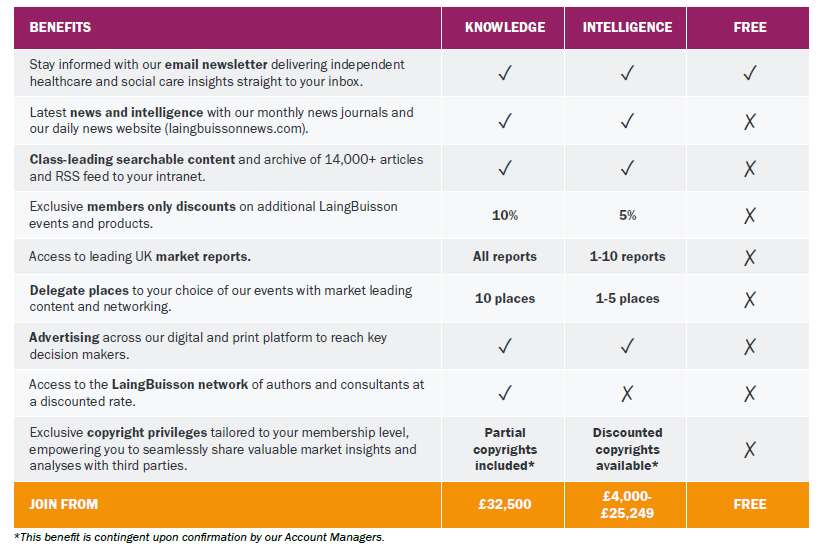
Demand for private health cover surges in the wake of Covid-19 and increasing pressure on the NHS
LaingBuisson has today launched the 18th edition of Health Cover UK Market Report.
Highlights of the market report include:
- UK health cover market valued at £6.2bn
- Proportion of UK population covered by Private Medical Insurance at its highest level since 2010 at 11.1%
- 18% jump in demand for dental insurance
Demand for private health cover, including Private Medical Insurance (PMI), health cash plans and dental cover, has reached its highest levels since 2010 as waits for NHS treatment continue to rise, according to research published today by LaingBuisson.
The value of the UK private health cover market reached an estimated £6,167m in 2021, helping fund private medical treatment, health cash plan benefits and dental treatments.
Private medical cover
Private Medical Cover (PMI and company-paid self-insurance schemes) represented the largest segment at £4,922m – up 1.3% on 2019 and 4.3% on 2020.
LaingBuisson’s latest Health Cover UK Market Report found an estimated 11.1% of the UK population was covered by PMI at the end of 2021 This is the highest penetration rate since 2010, although it remains significantly below the peak recorded in 2002.
Private medical cover pays for about half of private hospital and specialist treatment carried out in the UK. Two-thirds of private medical cover is funded by employers as an employee benefit. The remaining third is paid by individual PMI policy holders.
The total number of lives covered by private health cover reached its highest level since 2008. Growth in company-paid PMI and self-insurance schemes was driven in part by a rise in the number of people in full time employment during 2020 and 2021. However, individually paid PMI grew by a record 7% in 2021.
Health cash plans
Premium income for health cash plans, which help to pay for ‘low ticket’ health expenses such as visits to dentists and opticians, was estimated at £453m in 2021. This is down slightly on 2020’s value of £465m.
However, while the number of total cash plan subscribers has been relatively stagnant since 2009, demand for company-paid health cash plans has risen since the 2008 financial crisis and experienced a strong uptick in 2021. At the same time, numbers of individually-paid cash plan subscribers have reduced. This mismatch could be due to some companies substituting high-ticket private medical cover with low-cost health cash plans in the period of economic uncertainty following the global crash.
Dental maintenance and insurance
Demand for dental insurance, as measured by contributor numbers and persons covered, saw record growth of 18% in 2021 after growing steadily from a relatively small base since 2007.
Dental maintenance plans, where patients pay a fixed annual sum to maintain their dental health, generated an estimated £649m in premium income in 2021, an increase of 7.3% on 2020 (£605m).
Growth in individual-paid demand for dental insurance has outpaced growth in demand growth for private medical cover, again possibly due to its lower price point.
Market outlook
The private health cover sector has been struggling to re-establish real terms growth since its expansion was halted in its tracks by the global financial crisis in 2007/08 and the ensuing recession.
Prospects for health cover are dominated by two opposing drivers:
- Access to NHS dentistry (which is increasingly limited since Covid) and lengthening NHS waits are driving consumers to take up health cover products
- The fall in disposable household income in 2022 and 2023 is a counter-driver of demand which is likely to carry through to 2024 and beyond.
Author of this year’s report, Riko Scandelius said:
“Despite market growth in 2021, each segment of UK health cover now serves a smaller proportion of the population than they did before the global financial crisis of 2007/08 and the deep UK recession that followed, with the exception of the small but rapidly growing dental insurance space. While nominal market value has grown with inflation, health cover providers have not yet succeeded in rebuilding the penetration level they were at more than a decade ago.
“The rapid deterioration of NHS waiting times and many other aspects of NHS services starting in 2020 should, all other things being equal, continue to be a major factor boosting company paid and individual demand for access to private healthcare through health cover products. Although history highlights the primacy of the state of the economy and consumer confidence, rather than state of the NHS, in shaping trends in demand, NHS waiting times are likely to need to reduce significantly before private health cover becomes a lower priority for customers.”






